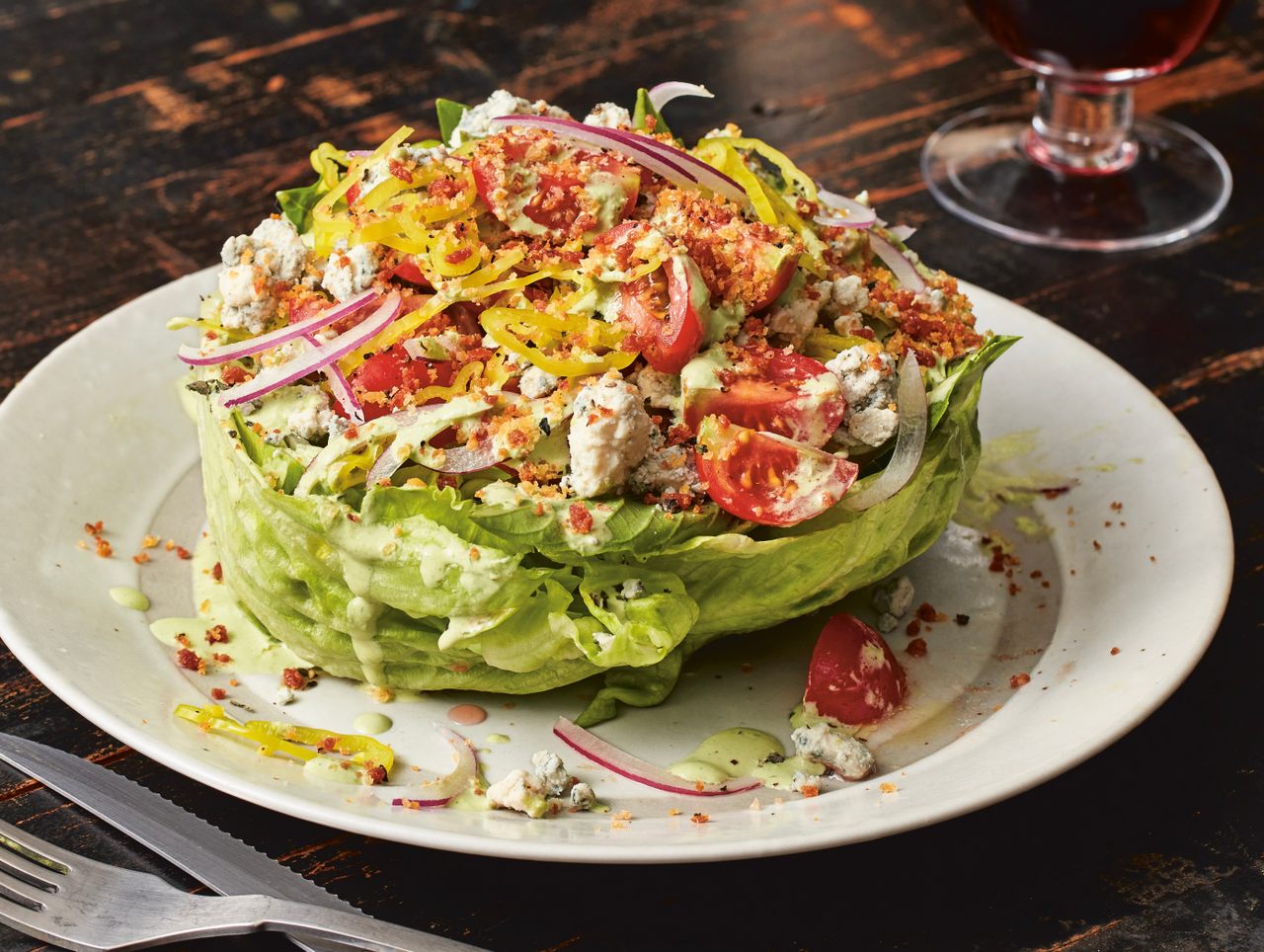How Iceberg Won the Lettuce Wars
The wedge salad’s dominance endures.
THIS ARTICLE IS ADAPTED FROM THE AUGUST 19, 2023, EDITION OF GASTRO OBSCURA’S FAVORITE THINGS NEWSLETTER. YOU CAN SIGN UP HERE.
I wish I had some sort of Proustian memory of a fancy steakhouse wedge salad, resplendent in blue cheese and crackles of bacon. But like most kids growing up in suburbia, my first exposure to iceberg lettuce involved a few wan hothouse tomatoes and a bottle of dressing with Paul Newman’s face on it.
By the time I was learning to cook as a teen, wedge salads and iceberg were hopelessly passé. I aspired to the salads spotted in the dog-eared pages of old Gourmets—turrets of microgreens and edible flowers à la Alice Waters, who famously snubbed iceberg—made in far-off places like San Francisco.
I’ve since seen the error of my snobby ways, and I’m not alone. In 2018, Helen Rosner at The New Yorker declared it the “superior lettuce” and that its ultimate iteration, the wedge salad, is an “irresistible combination of salt, fat, and thunderous crunch.”
These days, the classic wedge salad—blue cheese or ranch, dressing bacon, a chunk of lettuce, a token garnish of tomato—is a feature at steakhouses everywhere. But I’ve also been eating decidedly less retro versions, covered in everything from black garlic-ranch to savory granola.
“Ten years ago, everybody started eating kale, and then they probably realized kale is kind of, whatever, it’s fine, but what’s more fun to eat?” says Scott Tacinelli, chef and co-owner of Don Angie, a Michelin-starred Italian-American restaurant in New York whose cookbook includes a wedge salad lashed with both red wine vinaigrette and an anchovy-forward riff on a green goddess dressing, plus a shower of breadcrumbs crisped in pepperoni fat.
“Iceberg doesn’t have vitamins,” Tacinelli continues. “But it has a lot of texture and a lot of water in it, which is pleasurable to eat. It makes your mouth salivate.”

The Tip of the Iceberg
As is often the case with iconic recipes, the origins of the wedge salad are murky. The earliest known iteration appears in a 1916 cookbook, Salads, Sandwiches and Chafing Dish Recipes, in which Marion Harris Neil penned a recipe for a “Lettuce Salad and Roquefort Dressing,” made by dousing lettuce hearts in a thick dressing with cheese.
By the 1920s, blue cheese-crowned salads were making the rounds in restaurants. In the 1950s, no steakhouse menu was complete without a stately hunk of iceberg lettuce luxuriously draped in ranch. Dramatic, delicious, and largely devoid of nutritional value, iceberg lettuce remained a fixture at fancy establishments well into the 1970s.
In addition to being an ideal vessel for creamy dressings and crunchy bits, iceberg is also something of a botanical marvel, one with a lineage stretching back thousands of years.
The cultivation of lettuce dates back to ancient Egypt, where it was considered an aphrodisiac and carved into hieroglyphic reliefs of gods and pharaohs. Both the Romans and the Greeks were partial to a variety resembling our modern-day romaine.
Thousands of years later, the W. Atlee Burpee seed company introduced iceberg to the world. “By reason of its remarkable solidity and crisp, crystalline appearance it well warrants the name—Iceberg,” read the Burpee’s Farm Annual for 1893. “Try it! and you will tell us that in all your experience you have seldom, if ever, had such grand heads of lettuce.”
The hardy vegetable must have seemed grand indeed back then. Stephen Block, who writes about the rise of iceberg on his blog The Kitchen Project, says, “It would have been a real novelty, this crisphead lettuce that held together like that.” Unlike most seasonal produce, it was highly profitable because it could be grown almost year-round.

A Christmas Miracle
Most importantly, these sturdy heads could hold up for thousands of miles on cross-country trips. In short, it was the perfect green for America’s increasingly industrialized food system.
“There was an article about them delivering iceberg lettuce to Indiana [in the dead of winter],” Block says. “Imagine having that at Christmas in 1915.”
A newspaper article from 1928 glowingly describes trains nearly a mile long racing to distribute lettuce worth $50,000 (more than $860,000 today) to eager families all over the nation. More than 1,000 tons of ice in each train kept the precious cargo fresh for the duration of the journey.
Compared to the abundant produce aisles of today, it’s hard to fathom how miraculous something so crisp and green would have tasted after months of preserved veggies and potatoes. Some believe that the name “iceberg” comes from these very train cars, which kept their precious cargo nicely chilled with blocks of ice, while others attribute it to its “ice-white color.”
Block believes the moniker has slightly more poetic origins, “All the leaves covering the head have dimples in them, and the morning dew catches in those,” he says. “And when the sun hits it, it looks like an iceberg.”
Iceberg quickly attained near ubiquity in many of the refrigerators proliferating in American homes by the 1930s. And while it may have dipped out of fashion for a while, iceberg never really went away. Even at its pop culture nadir, it continued to outsell most other varieties of lettuce for decades.
“I think when it comes to just sheer deliciousness, people always loved iceberg lettuce,” says Angie Rito, chef and co-owner at Don Angie. “Nobody ever stopped loving it. They were just looking for the next best thing for a while.”
Gastro Obscura covers the world’s most wondrous food and drink.
Sign up for our regular newsletter.




























Follow us on Twitter to get the latest on the world's hidden wonders.
Like us on Facebook to get the latest on the world's hidden wonders.
Follow us on Twitter Like us on Facebook